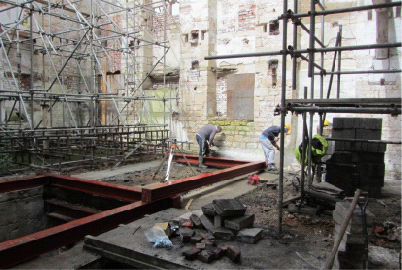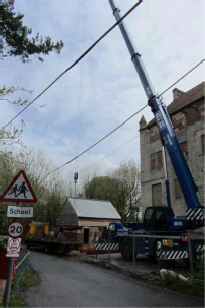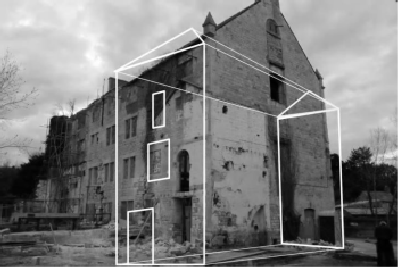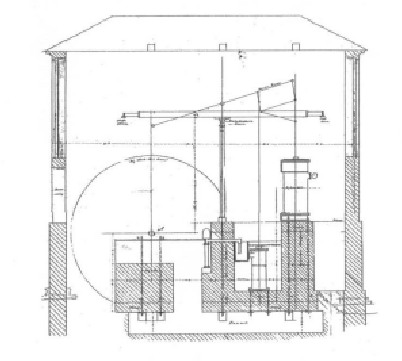


Millend Mill – 2012 an eventful year
Developments at the Mill
It’s been some time since we reported on progress with the restoration and conversion of Millend Mill to apartments. As most people will know, after making a start on the process, the original developer was unable to continue, and the project was sold on. Despite the sorry state of the mill, the new developers have since picked up the pieces and have been making significant progress.
Not only have they had to focus on the actual conversion, they have also had to deal with problems of crumbling stonework, decades of shoddy repairs by previous owners, and the difficulties of working in what is quite a constricted area.
Starting assembly of the mill’s new steel framework
During the past year, a new ground floor was installed and a massive steel frame built within the existing mill. This not only strengthened the 200 year old walls, but also forms an immensely strong structure to carry the new interior.
New concrete floors and internal walls for the upstairs apartments have been constructed on the upper floors and a lift shaft built in the centre of the mill. Alongside the regular builders, a team of carpenters is now busy on site.
Some months ago, the remaining section of the roof was finally removed, since replaced with a completely new structure. The original roof trusses were so badly rotted as a result of water ingress that in places, they were collapsing and pushing the top of mill’s walls outwards. Their timely removal helped avoid any further damage.
The new trusses were craned into place in December and the roof felted over just before Christmas. After so many years, the mill is now relatively water-

Sections of the new steel framework being craned into place.
Inside, the two surviving water wheel pits were uncovered again, and a new lift shaft partially built over the central one. It’s hoped that some form of water wheel can be built and installed in the other pit to drive a generator, giving the opportunity of producing some electricity from the waters of the Frome.
There is a lot of untapped potential for small scale hydroelectric power generation in the Stroud valleys, most of which remains unused.
Hopefully, something will come of this scheme, once again, putting the mill at the forefront of technological developments.
Fortunately, despite the worst flooding the village has seen in decades, there was no flooding at the mill. However, because of the ‘once in a century’ risk of flooding, the ground floor of the mill will not be used for apartments, simply as an entrance lobby. The ceiling of this is supported on very attractive recycled cast iron columns, brought in from elsewhere. These will make a nice feature of appropriate age.
Historical findings
From an archaeological point of view, the most interesting thing to come to light has been the remains of the steam engine house, added to the end of the mill some time around 1820.
As mills became bigger and installed more machinery, greater amounts of power were needed. There was only so much that could be provided by water wheels (and of course, water was sometimes in short supply), so a few enterprising cloth mill owners of the period installed steam engines to boost their mill’s output. The one at Millend was installed by Henry Hicks and was one of the earliest beam engines in Gloucestershire. It produced 14 horse power and was supplied by Boulton & Watt, one of the most iconic firms of the industrial revolution. It doubtless gave Hicks the edge over many of his competitors as he was now able to keep his mill running whatever the weather.
During the past year, the developers finally removed some of the concrete base of the now-
Remarkably, much of the engine’s base survives below ground level. This, as well as other evidence relating to the engine house, now visible on the mill’s eastern wall, was carefully recorded and reported, before it was covered up again.
This was a find of some importance as there were relatively few such engines installed in Gloucestershire as a whole. Any information only helps paint a fuller picture.
Full details of the excavation are available on the Gloucestershire Society for Industrial Archaeology’s website at: http://www.gsia.org.uk/reprints/2011/gi201103.pdf



Right: How the Millend engine house originally looked. The graphic is fitted to the surviving footprint and is based on the dimensions of a similar engine house that stood nearby at Churchend Mill.
Right: Part of the surviving large stone platforms that carried the engine’s main components. The blocked openings in the mill wall were probably where power was transferred into the mill.
Left: Side view of how the engine house with the beam engine inside (from Boulton & Watt records of 1820). Much, such as the large stone plinths that supported the engine, survives below ground level.

Published in ECN 137 Feb/Mar 2013
Millend Mill restoration

